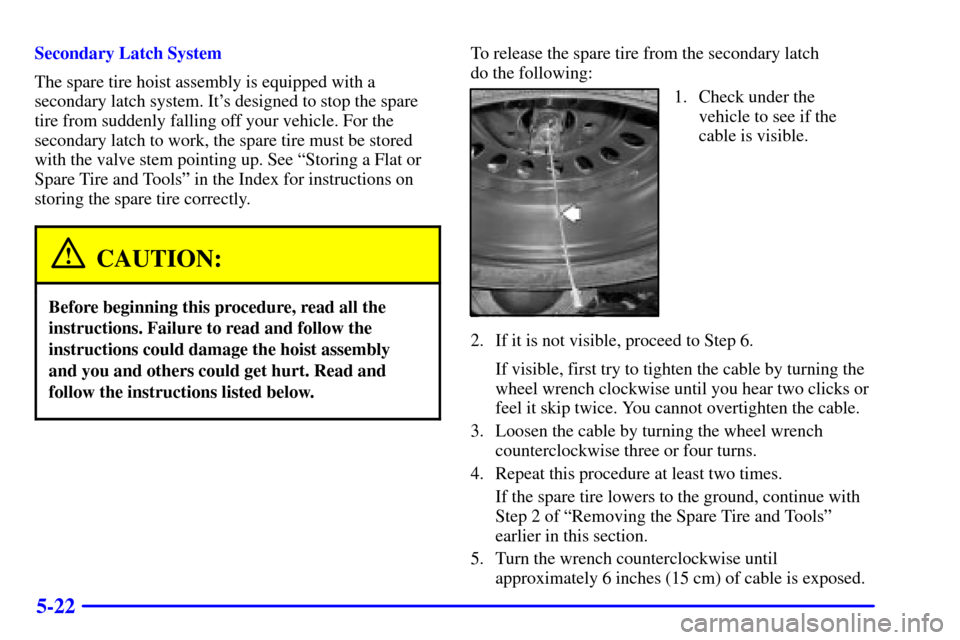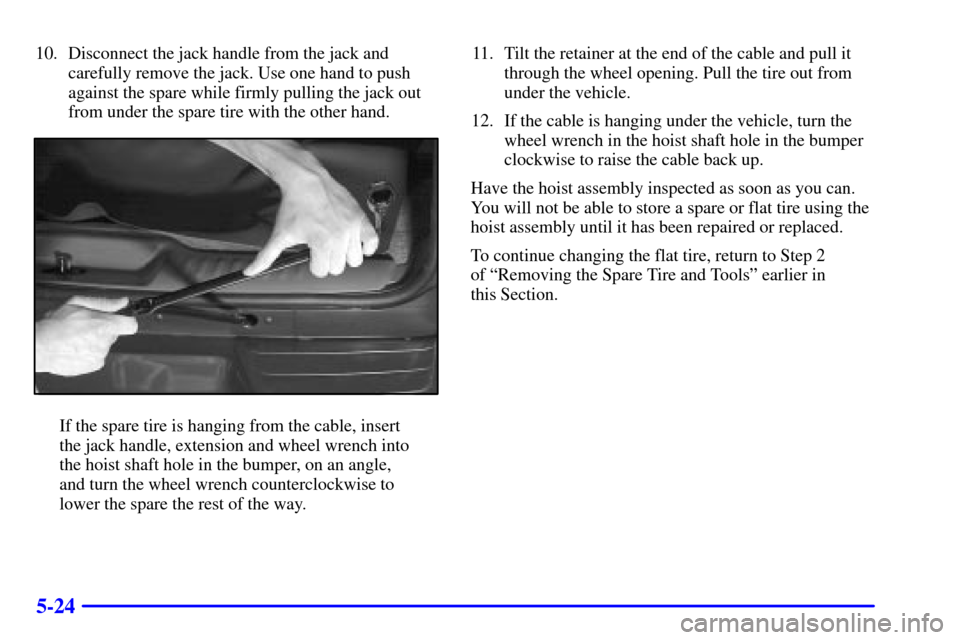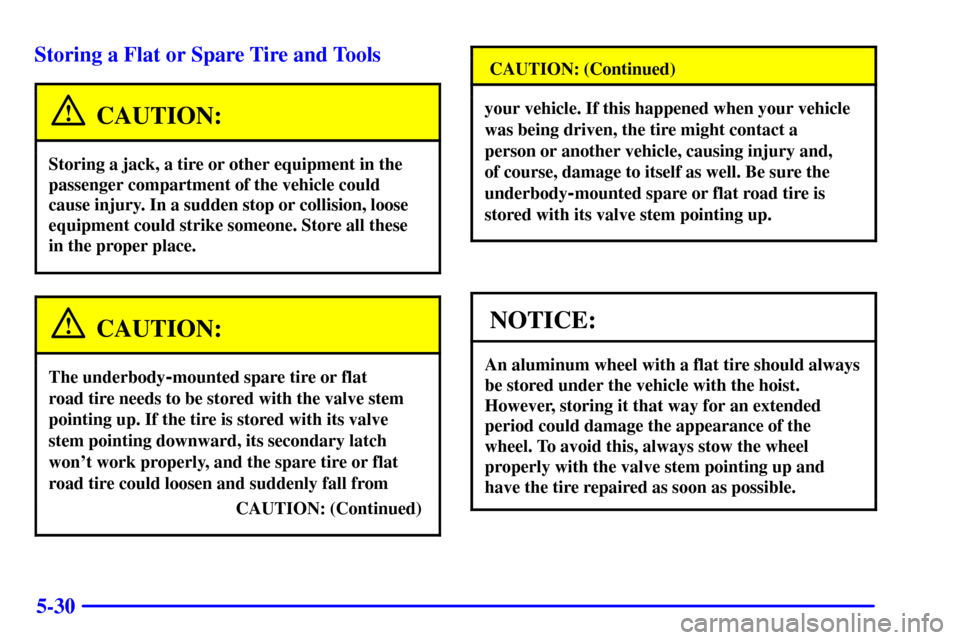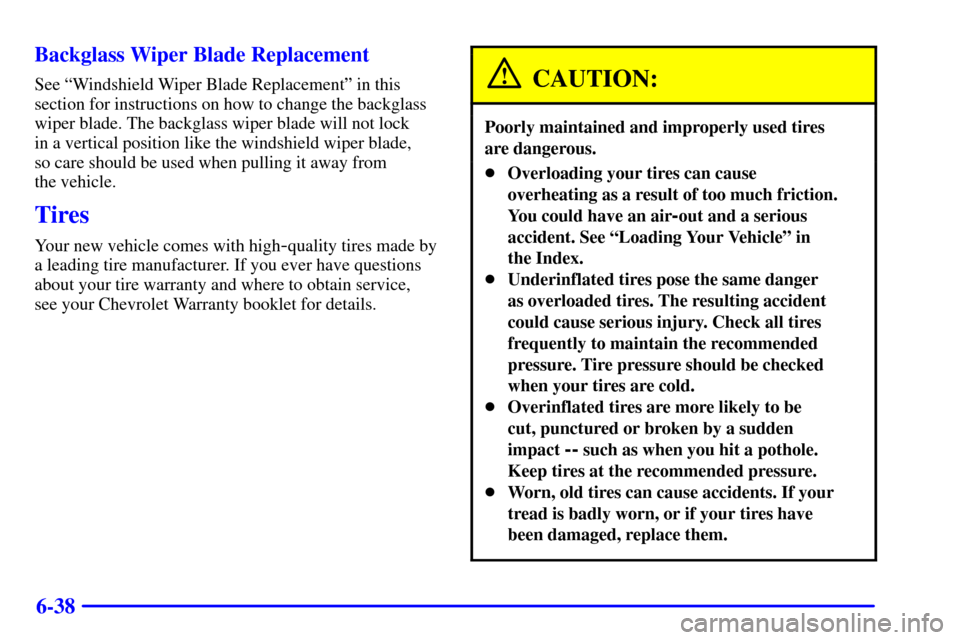Page 313 of 432
5-21
2. Turn the wheel wrench counterclockwise to lower
the spare tire. Keep turning the wheel wrench
until the spare tire can be pulled out from under
the vehicle.
If the spare tire does not lower to the ground,
the secondary latch is engaged causing the tire not
to lower. See ªSecondary Latch Systemº later in
this section.
When the tire has been completely lowered, tilt the
retainer at the end of the cable and pull it through
the wheel opening. Pull the tire out from under
the vehicle.
NOTICE:
To help avoid vehicle damage, do not drive the
vehicle before the cable is properly stored.
3. Put the spare tire near the flat tire.
4. Use the chisel end of the wheel wrench to pry off
the center cap.
See ªRemoving the Flat Tire and Installing the
Spare Tireº later in this section to continue changing
the flat tire.
Page 314 of 432

5-22
Secondary Latch System
The spare tire hoist assembly is equipped with a
secondary latch system. It's designed to stop the spare
tire from suddenly falling off your vehicle. For the
secondary latch to work, the spare tire must be stored
with the valve stem pointing up. See ªStoring a Flat or
Spare Tire and Toolsº in the Index for instructions on
storing the spare tire correctly.
CAUTION:
Before beginning this procedure, read all the
instructions. Failure to read and follow the
instructions could damage the hoist assembly
and you and others could get hurt. Read and
follow the instructions listed below.
To release the spare tire from the secondary latch
do the following:
1. Check under the
vehicle to see if the
cable is visible.
2. If it is not visible, proceed to Step 6.
If visible, first try to tighten the cable by turning the
wheel wrench clockwise until you hear two clicks or
feel it skip twice. You cannot overtighten the cable.
3. Loosen the cable by turning the wheel wrench
counterclockwise three or four turns.
4. Repeat this procedure at least two times.
If the spare tire lowers to the ground, continue with
Step 2 of ªRemoving the Spare Tire and Toolsº
earlier in this section.
5. Turn the wrench counterclockwise until
approximately 6 inches (15 cm) of cable is exposed.
Page 316 of 432

5-24
10. Disconnect the jack handle from the jack and
carefully remove the jack. Use one hand to push
against the spare while firmly pulling the jack out
from under the spare tire with the other hand.
If the spare tire is hanging from the cable, insert
the jack handle, extension and wheel wrench into
the hoist shaft hole in the bumper, on an angle,
and turn the wheel wrench counterclockwise to
lower the spare the rest of the way.11. Tilt the retainer at the end of the cable and pull it
through the wheel opening. Pull the tire out from
under the vehicle.
12. If the cable is hanging under the vehicle, turn the
wheel wrench in the hoist shaft hole in the bumper
clockwise to raise the cable back up.
Have the hoist assembly inspected as soon as you can.
You will not be able to store a spare or flat tire using the
hoist assembly until it has been repaired or replaced.
To continue changing the flat tire, return to Step 2
of ªRemoving the Spare Tire and Toolsº earlier in
this Section.
Page 317 of 432
5-25 Removing the Flat Tire and Installing
the Spare Tire
1. Using the wheel wrench, loosen all the wheel nuts.
Don't remove them yet.
2. Turn the jack adjusting knob clockwise by hand to
raise the jack lift head.
3. Place the handle, extension and wheel wrench onto
the jack.
Page 319 of 432
5-27
4. Place the jack in the appropriate position nearest the
flat tire.
CAUTION:
Getting under a vehicle when it is jacked up is
dangerous. If the vehicle slips off the jack, you
could be badly injured or killed. Never get under
a vehicle when it is supported only by a jack.
CAUTION:
Raising your vehicle with the jack improperly
positioned can damage the vehicle and even make
the vehicle fall. To help avoid personal injury and
vehicle damage, be sure to fit the jack lift head into
the proper location before raising the vehicle.
5. Raise the vehicle by turning the jack handle clockwise.
Raise the vehicle far enough off the ground so there is
enough room for the spare tire to fit.
6. Remove all the wheel nuts and take off the flat tire.
Page 322 of 432

5-30 Storing a Flat or Spare Tire and Tools
CAUTION:
Storing a jack, a tire or other equipment in the
passenger compartment of the vehicle could
cause injury. In a sudden stop or collision, loose
equipment could strike someone. Store all these
in the proper place.
CAUTION:
The underbody-mounted spare tire or flat
road tire needs to be stored with the valve stem
pointing up. If the tire is stored with its valve
stem pointing downward, its secondary latch
won't work properly, and the spare tire or flat
road tire could loosen and suddenly fall from
CAUTION: (Continued)
CAUTION: (Continued)
your vehicle. If this happened when your vehicle
was being driven, the tire might contact a
person or another vehicle, causing injury and,
of course, damage to itself as well. Be sure the
underbody
-mounted spare or flat road tire is
stored with its valve stem pointing up.
NOTICE:
An aluminum wheel with a flat tire should always
be stored under the vehicle with the hoist.
However, storing it that way for an extended
period could damage the appearance of the
wheel. To avoid this, always stow the wheel
properly with the valve stem pointing up and
have the tire repaired as soon as possible.
Page 323 of 432
5-31
Follow this diagram to store the underbody-mounted spare.
A. Wheel Wrench
B. Hoist Shaft
C. Extension
D. Retainer
E. Spare or Flat Tire
(Valve Stem Pointed Up)
1. Put the tire on the ground at the rear of the vehicle,
with the valve stem pointed up and to the rear.
2. Pull the retainer through the wheel.
3. Put the socket end of the extension, on an angle,
through the hole in the rear bumper and into the
hoist shaft.4. Raise the tire fully against the underside of the
vehicle. Continue turning the wheel wrench until
the tire is secure and the cable is tight. The spare
tire hoist cannot be overtightened.
5. Make sure the tire is stored securely. Push, pull, and
then try to rotate or turn the tire. If the tire moves,
use the wheel wrench to tighten the cable.
Page 364 of 432

6-38 Backglass Wiper Blade Replacement
See ªWindshield Wiper Blade Replacementº in this
section for instructions on how to change the backglass
wiper blade. The backglass wiper blade will not lock
in a vertical position like the windshield wiper blade,
so care should be used when pulling it away from
the vehicle.
Tires
Your new vehicle comes with high-quality tires made by
a leading tire manufacturer. If you ever have questions
about your tire warranty and where to obtain service,
see your Chevrolet Warranty booklet for details.
CAUTION:
Poorly maintained and improperly used tires
are dangerous.
�Overloading your tires can cause
overheating as a result of too much friction.
You could have an air
-out and a serious
accident. See ªLoading Your Vehicleº in
the Index.
�Underinflated tires pose the same danger
as overloaded tires. The resulting accident
could cause serious injury. Check all tires
frequently to maintain the recommended
pressure. Tire pressure should be checked
when your tires are cold.
�Overinflated tires are more likely to be
cut, punctured or broken by a sudden
impact
-- such as when you hit a pothole.
Keep tires at the recommended pressure.
�Worn, old tires can cause accidents. If your
tread is badly worn, or if your tires have
been damaged, replace them.